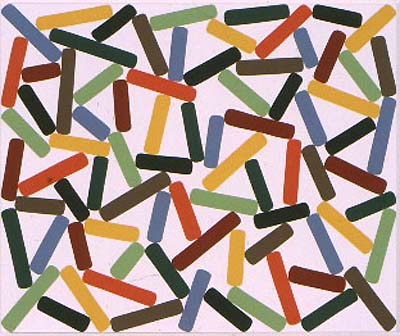 Warren Isensee: De Stijl Life, 2003 Oil on canvas, 50" x 60" Makeover ChanSchatz, Angelo Filomeno, Changha Hwang, Warren Isensee, David Krippendorff Massimo Audiello continues the investigation of contemporary methods of abstraction and while the newly remodeled gallery is not actually the subject of this show, it does provide a wonderfully fresh setting for viewing paintings which re-make the formally familiar. Each of these artists uses a unique set of formal constraints to pursue the evasive sense of our layered existence. The show makes it evident that precision has many demands, as none of these artists have the luxury of indulging in technical shortcuts. But the precision of these works is not superfluous or merely decorative; on the contrary, it is absolutely necessary to their meaning. ChanSchatz combines the mathematical system with the human hand to transform personal idiosyncrasy into an elegant new alphabet. The duo works with critics, curators, and collectors to generate unique digital paintings. They use a layered network of "choices", leaving certain aspects the painting's design independent, so to speak, of pure authorship. The resulting hybrid surfaces are like organically inspired industries so that when you approach these paintings there is a sense of looking through a glass bottomed boat into a man-made coral reef: layers of color and movement seem to be the expression of an intelligent ecosystem rather than an individual. Angelo Filomeno's "painting" is deceptively delicate. Over the years he has developed a technique whereby iconic images are painstakingly embroidered onto silk fabric and then stretched over canvas. Power is elicited from the incalculable number of stitches which simultaneously construct and cocoon the chosen objects of flora, fauna, and human history. The combinations seem hauntingly irreversible, but the shimmer of silk conveys the myth maker's lyrical sense of hope. Changha Hwang layers grid upon grid, leading the viewer through complex paths to focus on negative spaces. These openings, or "by-products", can only be created by a process of accretion, and Hwang works his paintings thoroughly to give an electric sense of life to this passage of painterly time. According to the artist, "…with layers and layers of paint in the form of grids and geometrical lines, the painting is built by a process of elimination". In Warren Isensee's paintings there is a carefully crafted optimism and sense of humor. Slightly imperfect geometries are painted to perfection in a studied way that uses color to throw shape out of balance. Tongue-in-cheek titles like de Stijl Life point to a relation between these beautiful abstractions and the double-edged evolution of Pop. David Krippendorff continues to question movie-made dreams, this time using nothing more than shades of white. The artist's fascination with the The Wizard of Oz has led to a series of paintings that rework particular film stills, taking something monumentally well known and transforming it into something with a great physical presence, but where the image is strangely difficult to locate. Cinematic vision has become the seductive raw material which the artist uses in order to question accepted notions of home, country and cultural identity while also investigating the depth of the painted image itself. June 17 - July 25, 2003 Hours: Tue-Sat 11 am - 6 pm Massimo Audiello Gallery 526 West 26th Street No. 519 New York, NY 10001 Telephone +1 212 675 9082 Fax +1 212 675 8680 Mail info@massimoaudiello.com www.massimoaudiello.com |